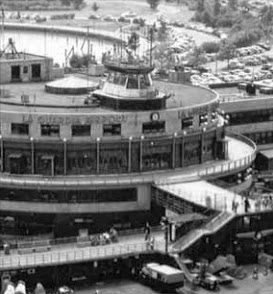New York City’s First Commercial Airport
Newark Airport, formally known as Newark Metropolitan
Airport, opened long before both JFK and LaGuardia on October 1, 1928. It operated for a time as the region’s only
commercial airport, located a mere fourteen miles from Manhattan. Before Newark, there was Heller Field, a US
Mail Airfield located in the North Ward, which lasted only a short while; from
December 1919 to May 1921. Hadley Field
soon replaced Heller Field in 1923 as the post office needed an air base. However, the four airlines using Hadley
ultimately made the transition to Newark Airport and the field was shut.
 |
| Mail workers unload the mail bags from the well in the front part of the fuselage. Photo: Newark Evening News, December 8, 1919, courtesy of Newark Public Library |
Plans to build the airport were announced on August 3, 1927
and the city moved with great haste in order to ensure the airport attracted
the air mail business, whose existing contracts were due to expire in
1928. Sure enough, the city’s efforts
paid off and on February 18, 1929, the airport officially opened as an Eastern
terminal for the United States air mail.
According to an article published in the Brooklyn Daily Eagle the
following day, more than 25,000 people showed up to witness the event, which was
marked by the takeoff of three planes, each of which departed at separate times while carrying
mail. In addition, the new airport had welcomed
its first international passengers on October 17, 1928, who flew in from
Montreal on a Canadian Colonial Airways Ford Tri-Motor.
 |
| Etching of Newark Airport by George A. Bradshaw for the Journal of Finance and Industry in 1929. Photo: Newark Public Library |
However, that is not say that construction of the airport
was simple; far from it! The airport was
located on swampland and so had to be raised by six feet and four miles of
creeks had to be diverted. To fill the
ground, the city used dry fill which consisted of 7,000 Christmas trees and 200
safes donated
Perhaps the only commercial NYC airport created outside the
influence of Fiorello LaGuardia, Newark was championed by Newark Mayor Thomas
Lynch Raymond. Unfortunately, however,
like LaGuardia in the case of JFK Airport, Raymond did not live to see the
fruits of his labor, dying days before the grand opening.
 |
| Newark had the world's first paved runway. Photo: Port Authority of NY & NJ, 1928, courtesy of Newark Public Library |
Noting the absurdity of the lengths the city
was going to in order to build the airport, one reporter urged his readers to, “Forget
the airport! The craze for aviation will
soon die out!” That reporter, however, could not have been
more wrong; not only was aviation to become massively popular, but it is
estimated that roughly 50,000 people went to visit the airport every Sunday
throughout the 1930s.
 |
| Newark's original Art Deco Administration Building, which served as a terminal building until the opening of North Terminal in 1953. Photo: Port Authority of NY & NJ |
Newark also paved the way for airports all over the world –
it was reputedly the first airport in the world to have a paved runway. It was also the first airport in the US to
build a terminal building. The opening of what is now Newark’s Administration
Building in 1935 was therefore a significant event. Amelia Earhart, the famed aviatrix, formally
dedicated it. Newark became the world’s
busiest airport, with 90,177 passengers in 1931 alone. Furthermore, Earhart was a frequent visitor of the airport and was one of the many celebrities often seen flying in and out.
 |
| In September 1930, passengers on the new Newark-Washington plane lined up to have their photo taken at Newark Airport. Left to right: J.V. MacGee, former Vice President of Transcontinental Air Transport; A.W. Gilliam, Washington newspaper representative; Amelia Earhart, Vice President of the line; Mrs. Mabel Walker Wllebrandt, former Assistant United States Attorney General; Major General J.E. Fechet, Chief of the United States Army Air Corps; Command J.Q. Walton of the Coast Guard; Sydney Gross of Washington. Photo: Newark Public Library |












